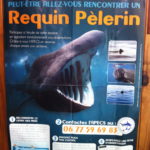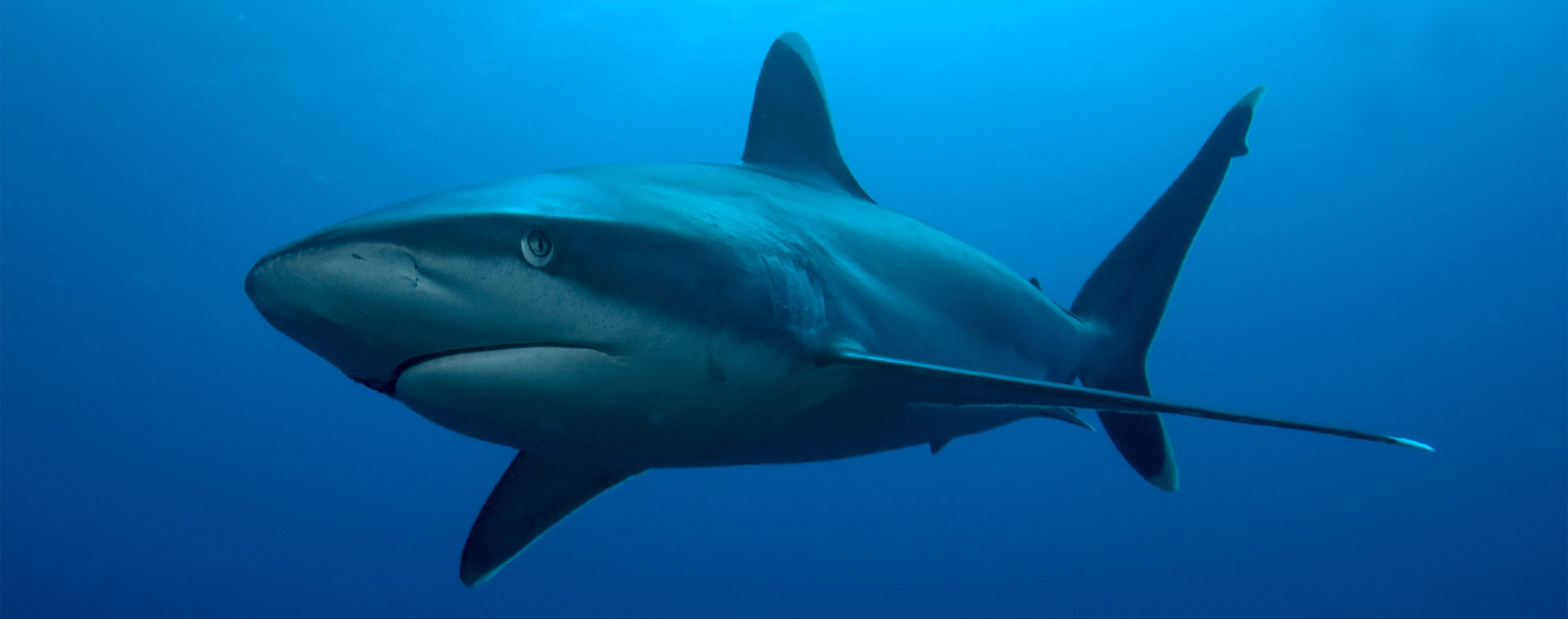Le 2ème plus gros poisson du monde : le requin pèlerin / The 2nd largest fish in the world, the basking shark
Le requin pèlerin (Cetorhinus maximus) peut atteindre 12 mètres (taille maximale, plus communément 8-9m) et peser jusqu’à 7 tonnes (le poids de 2 éléphants adultes). Pourtant, le second plus gros poisson du monde est inoffensif.
The basking shark, scientific name Cetorhinus maximus, Manx name Gobbag vooar (big mouth) is the second largest fish in the world. It is named basking shark because of its habit of ‘basking’ at the surface of the water. Historical accounts give maximum sizes for basking sharks of 40-46 ft (12-13.72 m). It seems reasonable to estimate a weight of about 7 tonnes for an 8.7m basking shark. This is about the weight of two fully grown elephants. Despite its huge size it is completely harmless to man.
Distribution et photo-identification / Geographical distribution and photo-identification
On le trouve dans toutes les mers tempérées du globe: Atlantique, Pacifique, Océan Indien. En Europe, on le croise au large de l’île de Man entre mai et septembre : c’est la période où le plancton est le plus abondant. Les lignes argentées que l’on aperçoit au large depuis les hauteur de l’île sont des bancs de plancton gras dont se nourrit principalement le requin pèlerin. Le plancton dérive vers le nord avec les courants forts et il semble bien que les requins pèlerins suivent le plancton.
Basking sharks have a worldwide distribution in cool temperate seas of temperature 8-14°C, being found in the Pacific, Atlantic and Indian Oceans. In Europe, basking sharks come to the coastal waters of the Isle of Man from mid May to the beginning of September, when plankton is more abundant. The silver lines that can be seen offshore from the height of the island are schools of fatty plankton on which feed mainly basking sharks. Plankton drifts northward with strong currents and it seems that basking sharks follow plankton.
Jusqu’à présent, seuls quelques spécimens ont été taggés, mais cela a permis d’en apprendre un peu plus sur cette espèce. Une femelle de 8 mètres, surnommée Tracy, a parcouru quelques 10000 km de l’île de Man jusqu’au Canada. Mais d’autres enregistrements évoquent des déplacements de requins pèlerins depuis l’Atlantique jusqu’à Gibraltar et la Méditerranée. Il faut surtout reconnaître que l’on ne sait pas grand-chose sur cette espèce. On estime toutefois la population mondiale à quelques 8000 individus. Le Dr Colin Speedie travaille avec l’European Basking Shark Photo-Identification Project (EBSPiP) pour tenter de comprendre les mouvements des requins pèlerins dans les mers du globe. L’aileron est au requin ce que l’empreinte digitale est à l’homme. Chez le requin pèlerin l’aileron dorsal peut atteindre 2m de hauteur.

So far, only a few specimens have been tagged, but it helped to learn a little more about this species. An 8-meters female, known as Tracy, traveled some 10,000 km from the Isle of Man to Canada. But other records suggest the movement of basking sharks from the Atlantic to Gibraltar and the Mediterranean. We must above all recognize that we do not know much about this species. However, the world population is estimated to some 8,000 individuals. Dr Colin Speedie is working with the European Basking Shark Photo-Identification Project (EBSPiP) to try to understand how far individual basking sharks move. The shark’s dorsal fin is, to shark, what the fingerprint is to man. The basking shark’s dorsal fin can be up to 2 metres tall.
Particularités physiques / Physical characteristics
Le requin pèlerin ouvre une gueule de 1,50 m de large et filtre 1000 litres d’eau par heure. De près, on peut voir ses 5 fentes branchiales garnies de membranes roses qui filtrent le plancton de l’eau de mer. La particularité physique du requin pèlerin, outre sa taille, est son « nez » proéminent. Basking sharks open a 1,5m-wide mouth and filter 1000 liters of seawater par hour. They feed by filtering out plankton from the water in a similar manner to whales. The five gill slits almost completely surround the head. The pink gill rakers, used for filtering their planktonic shrimp food from the water, are visible if you are too close! One particular characteristic of the basking shark, except its size, is its bulbous nose.
 Ses petits yeux ne sont probablement pas directement important dans la localisation de sa nourriture, mais il est probable qu’ils jouent un rôle important en tant que détecteurs de lumière, aidant les requins-pèlerins à détecter l’évolution des niveaux de lumière quand ils se déplacent de haut en bas dans la colonne d’eau essayant de trouver de la nourriture. Les Docteurs Matthews et Parker ont révélé que le centre olfactif occupe une aire de 15 cm de long dans le cerveau, alors que l’ensemble du reste du cerveau ne dépasse pas 10,5 cm de long! The tiny eyes are probably not directly important in locating its food but it is probable that they are important as light detectors, helping the basking sharks to detect changing light levels when they are moving up and down through the water column trying to locate food. Drs Matthews and Parker found that the brains olfactory tract, where the sense of smell is processed, is 15cm long whereas the whole of the rest of the brain is only 10.5 cm long! If basking sharks allocate that much relative brain power to smell it would seems to indicate that smell is VERY important to basking sharks!
Ses petits yeux ne sont probablement pas directement important dans la localisation de sa nourriture, mais il est probable qu’ils jouent un rôle important en tant que détecteurs de lumière, aidant les requins-pèlerins à détecter l’évolution des niveaux de lumière quand ils se déplacent de haut en bas dans la colonne d’eau essayant de trouver de la nourriture. Les Docteurs Matthews et Parker ont révélé que le centre olfactif occupe une aire de 15 cm de long dans le cerveau, alors que l’ensemble du reste du cerveau ne dépasse pas 10,5 cm de long! The tiny eyes are probably not directly important in locating its food but it is probable that they are important as light detectors, helping the basking sharks to detect changing light levels when they are moving up and down through the water column trying to locate food. Drs Matthews and Parker found that the brains olfactory tract, where the sense of smell is processed, is 15cm long whereas the whole of the rest of the brain is only 10.5 cm long! If basking sharks allocate that much relative brain power to smell it would seems to indicate that smell is VERY important to basking sharks!
Taille, maturité sexuelle, reproduction, et gestation / Size, sexual maturity, reproduction and pregnancy
Aucune observation de bébé pèlerin n’a été faite autour de l’île de Man, il est donc probable que les mises bas se fassent ailleurs. Aucun accouplement non plus n’a pus être filmé. Les nouveaux-nés mesurent entre 1,5m et 2 m de long, les jeunes de l’année atteignent 2 à 3 m. Vers 3-4 ans, ils mesurent 5m et leur taille adulte de 10 est atteinte entre 8 et 15 ans. On ne connaît pas la longévité du requin pèlerin, peut-être 30 à 50 an? Il est donc possible que de plus grands requins pèlerins existent ?… La maturité sexuelle est atteinte entre 6 et 9 m. No newborn sharks have been observed yet around the Island of Man. No one is sure where the females have their young. No mating has been film neither. Newborn sharks are about 1.5m–2 m long. The young-of-the-year sharks that appear inshore in June and July are 2-3 m. Basking sharks reach 5m by age 3-4 years and 10m by approximately 8 to 15 years. It is not known how long basking sharks live but it may be 30-50 years, so the possibility for bigger basking sharks does exist. Basking sharks are immature up to 6m in length and become sexually mature adults when they reach 6-9m.
Ovipares, les jeunes éclosent éclosent à partir d’oeufs dans l’utérus et naissent vivants ; entre-temps, les premiers embryons éclos dans l’utérus se nourrissent des autres oeufs. Ce phénomène est connu sous le nom d’oophagie. Quant à la durée de la gestation, chez d’autres requins vivipares, elle peut être de 22 mois. Plusieurs théories coexistent entre 12 à 36 mois! Bref, cette donnée est manquante, mais le fait est que la maturité sexuelle tardive et la longue durée de gestation rendent l’espèce encore plus fragile. Quite a lot is known about basking shark courtship but very little is certain about their gestation or where they give birth. The terminology surrounding basking shark reproduction can be quite confusing but they are live bearing (this is called being viviparous); the young hatch from eggs inside the uterus (this is called being oviparous) and the developing embryos nourish themselves by eating eggs in the uterus (they are oophagous). It is not clear how long the gestation period of the basking shark is. Gestation in some other viviparous (live-bearing) sharks is known to be about 22 months. There have been various suggestions from 12 to 36 months. The conclusion? It is not known how long a developing basking shark spends in its mothers uterus! But the fact is that the species is very vulnerable because its late sexual maturity and its long gestation period.
Menaces / Threats
Classé Vulnérable par l’UICN et en annexe II de la CITES, le requin pèlerin est gravement menacé. Outre une reproduction très lente (maturité sexuelle tardive, gestation longue), il a été très largement pêché pour son foie pouvant atteindre 1 tonne et ses énormes ailerons. Il existe encore des pêcheries de requins pèlerins. Mais les prises accidentelles dans des filets font de nombreuses victimes qu’il s’agisse de filets dérivants ou de filets fantômes (restes de filets abandonnés en mer).
Classified Vulnerable by IUCN and in Annex II of CITES, basking sharks are particularly vulnerable to over-expoitation as they breed excessively slowly. Unfortunately for the basking shark it has long been a fishery target as its one-ton liver is exceedingly rich in commercially valuable oils, and its enormous fins are used in Chinese sharks’-fin soup. Targeted basking shark fisheries still exist and huge numbers of basking sharks are accidentally caught in fishing nets worldwide. These accidental basking shark catches are often de-finned as the sharks’ fins command large prices.
